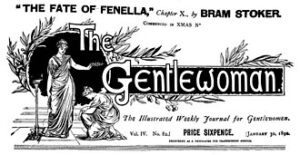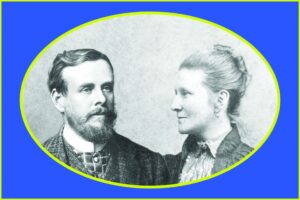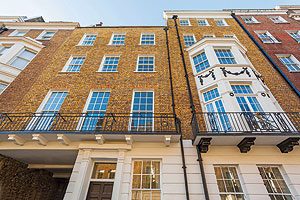“[One] of the most notable and charming women of the day…” and her “museum” – 13 Great Cumberland Place, London, W1

Both Theodore and Mabel Bent liked to style themselves ‘archaeologists’, and at times a case can be made that they were… and at others that they were anything but. But there can be no doubting they were truly exceptional travellers and explorers, regularly facing uncertainty and considerable hardships over a period of almost twenty years – ‘excavating’ where they could, usually in line with whatever Theodore’s current hobby-horse happened to be – early life in the Cyclades, the Phoenicians, the Queen of Sheba…

The Bents are an amazingly addictive couple and ‘the archaeology of the Bents’ is very much part of what the Bent Archive is all about. And now and then, once in twenty years of research, something truly remarkable, unique even, comes to light. The late summer of 2020 produced just such a discovery, beginning with an insignificant alert from the British Newspaper Archive saying that a quality women’s magazine, The Gentlewoman, had been added to its list of digital holdings, most of which originate from the British Library. Straightaway the search term ‘Theodore Bent’ (which will turn up either Mr or Mrs J. Theodore Bent) went in, and, just like an excavator in an opening trench, you wait to see if anything comes up. Bingo! There it was – The Gentlewoman – The Illustrated Weekly Journal for Gentlewomen, Vol. VII, Saturday, November 11, 1893, pages 621-622, Article title: Gentlewomen ‘At Home’, No. CLXXV, ‘Mrs. Theodore Bent… at 13, Great Cumberland Place’.

An astonishing discovery, and for us as intriguing as anything the Bents brought home to London from the Eastern Mediterranean, Africa, or Arabia. And what makes the article so appealing is that it is the only piece unearthed so far that goes into any detail about the Bents’ archaeological and ethnographic finds that they had out on show in their London townhouse (an invitation and victim to the Blitz), 13 Great Cumberland Place, just a few hundred metres from Marble Arch. A further discovery is that the article also contains a very rare portrait of Mabel (which our research shows is by Henry Van der Weyde); there are also three unique photographs, sadly very dark, of the interior of their house.
This revelatory article from The Gentlewoman is now transcribed below and we make no apologies for its length – you can return to it as often as you like, and it is probably the first time for a hundred years it will have been re-read. Its context (and once more we have archaeology), reinforces the aura of celebrity the Bents had acquired following their 1891 trip to ‘Great Zimbabwe’, with Cecil Rhodes scheming behind him – and in a sense the great ‘Colossus’ made a minor one of Theodore, and Mabel too.
The last few paragraphs of the piece make reference to the 1893 scandal involving the controversy of whether women should continue being elected Fellows of the Royal Geographical Society – Mabel was in the proposed second cohort (22 or so had been elected thus far), but the RGS hierarchy managed to ban them from applying. It was a sorry story, not put right until 1913.
It is also worth noting that some of the dates mentioned in the article are inaccurate for some reason – perhaps Mabel’s memory let her down during the interview with the editor.

Nor does the article always make for happy reading – there are inclusions and stray finds that are unwelcome today, but which were the matrix of the day – the discovery that two ikons from the Patmos’ ‘Cave of the Apocalypse’ were removed is a shock (although Mabel in her diary records that at least one was ‘purchased’). Mabel died in 1929 and a few years previously she donated some of the artefacts she held most dear, those that reminded her most of happier times before Theodore’s early death in 1897, to the British Museum. All her remaining assets were bequeathed to her nieces, and her collections divided up, dispersed, sold off, reverting to anonymous items, and now in the main contextless, provenances lost. And the Patmos ikons? Where they are today, we don’t know. Let’s hope some future archaeologist turns them up and sees these little treasures returned to the Dodecanese…
… but let’s make a start on the transcription, and hand you over to Theodore and Mabel, in one of their cluttered drawing rooms, carriages rattling along in the street below, being interviewed by the editor of The Gentlewoman, Joseph Snell Wood. It is Autumn in London in 1893, an empire’s heyday, and the leaves in Hyde Park are changing colour…
Gentlewomen ‘At Home’, ‘Mrs. Theodore Bent… at 13, Great Cumberland Place’
 Leave a comment or contact us about this article
Leave a comment or contact us about this article
